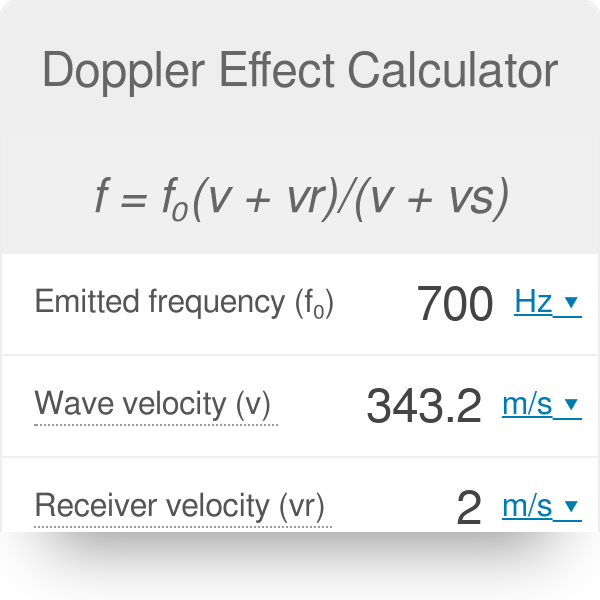


The proposed DE-MEDT algorithm’s efficiency is evaluated by solving well-known unconstrained and constrained optimization problems. Since the proposed algorithm simultaneously utilizes the DE equation and MEDT mechanism, it is called the Doppler Effect-Mean Euclidian Distance Threshold (DE-MEDT) metaheuristic algorithm. The proposed MEDT mechanism is also employed to avoid the locally optimum solutions and increase the convergence rate of the presented optimizer. A new mechanism named Mean Euclidian Distance Threshold (MEDT) is introduced to enhance the quality of the observers. In the proposed algorithm, the observers’ velocities as the algorithm’s search agents are updated based on the DE equation. Thus, a new physics-based Metaheuristic (MH) optimizer is developed.

#DOPPLER EFFECT EQUATION DE UPDATE#
In this paper, we use the mathematical formulation of DE with some idealized rules to update the observer velocity existing in the Doppler equation. In recent years, the mathematical formulation of this phenomenon has been used to improve the frequency equation of the standard Bat Algorithm (BA) developed by Yang in 2010. The equation for relativistic Doppler effect at an arbitrary angle for a stationary receiver and a moving light source is f/f 1/Gamma (1- Beta cos. Named after Austrian physicist, Christian Andreas Doppler (1803-1853) 1.School of Civil Engineering, Iran University of Science and Technology, Narmak, 16846-13114, Tehran, Iranĭoppler Effect (DE) is a physical phenomenon observed by Doppler, an Austrian mathematician, in 1842. the Greek letter theta (θ) is also used.Q is the angle between ultrasound beam and axis of flow.c is the velocity of sound in the medium.f o is transmitted frequency from ultrasound probe.This is accounted for in the Doppler equation with the "cosine(θ)" parameter the maximum Doppler shift occurs when the relative motion occurs at a Doppler angle of 0 degrees (the cosine of 0 = 1) and no Doppler shift will be noted when the motion of the reflecting source is perpendicular (cosine of 90 = 0) 3. The magnitude of the Doppler shift is also affected by the angle at which the reflecting source is travelling in relation to the transmitting source. spectral envelope (in continuous and pulsed wave Doppler) below the baseline.depicted in colour flow Doppler as blue.source reflecting sound waves is moving away from the emitting source.frequency of received sound waves spectral envelope (in continuous and pulsed wave Doppler) above the baseline.source reflecting sound waves is moving toward the emitting source.frequency of received sound waves > frequency of emitted sound waves.an ultrasound transducer) the frequency of the sound waves received will be higher (positive Doppler shift) or lower (negative Doppler shift) than the frequency at which they were emitted, respectively 2. To do this, you just have to take the standard wave equation and perform a variable substitution x y: x v t x y : x v t.

However, if the reflecting source is in motion either toward or away from the emitting source (e.g. 1 Answer Sorted by: 4 If I understand you correctly, you want to desribe sound waves from the viewpoint of a moving observer. When sound of a given frequency is discharged and subsequently reflected from a source that is not in motion, the frequency of the returning sound waves will equal the frequency at which they were emitted. Doppler shift or Doppler effect is defined as the change in frequency of sound wave due to a reflector moving towards or away from an object, which in the case of ultrasound is the transducer.


 0 kommentar(er)
0 kommentar(er)
